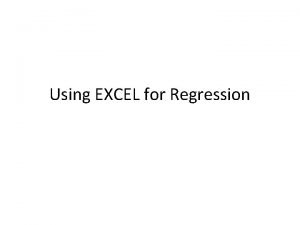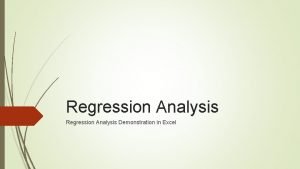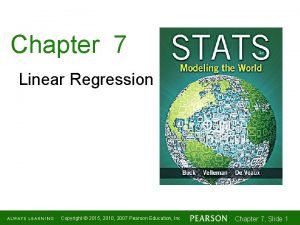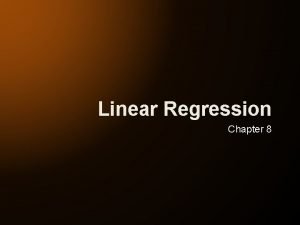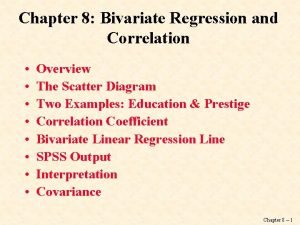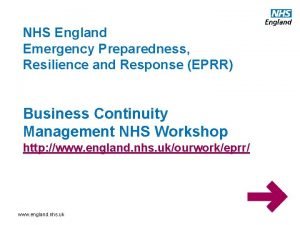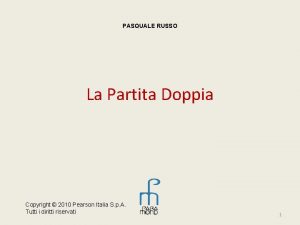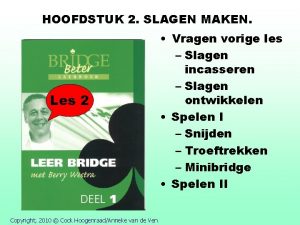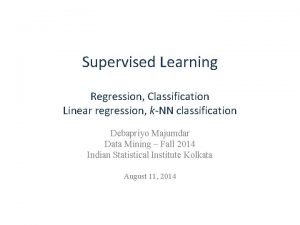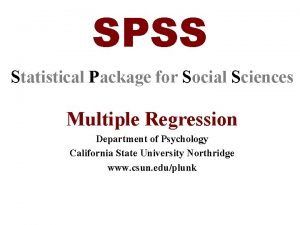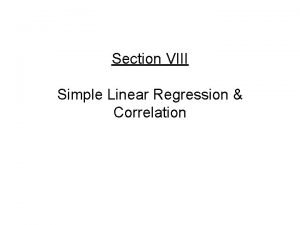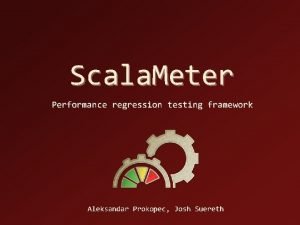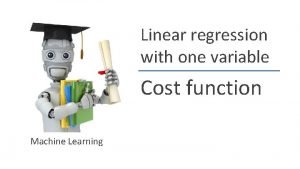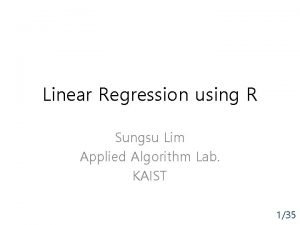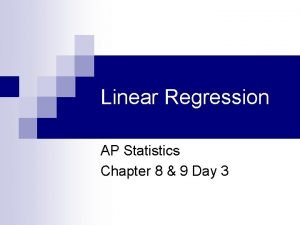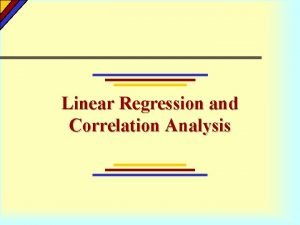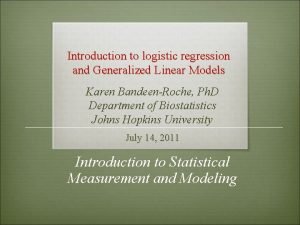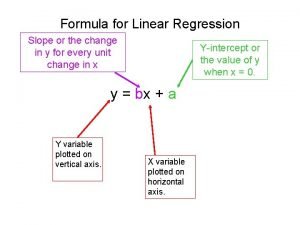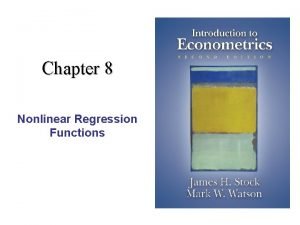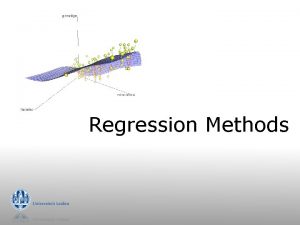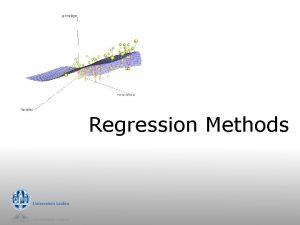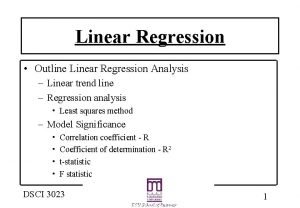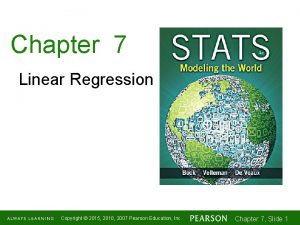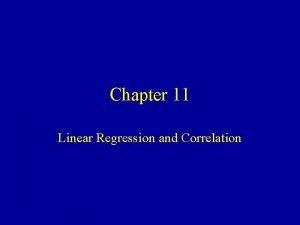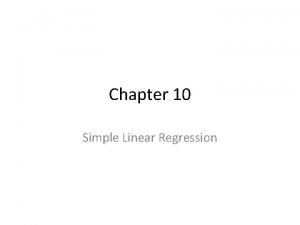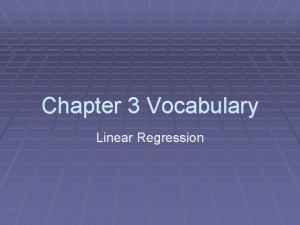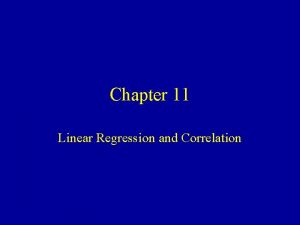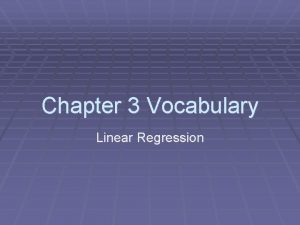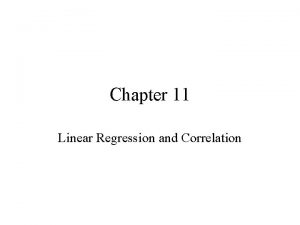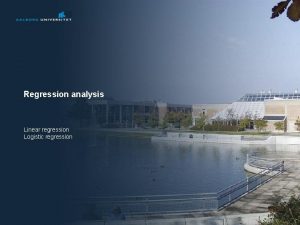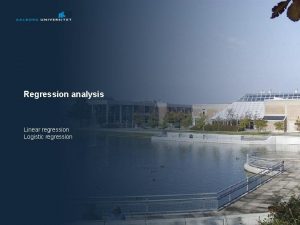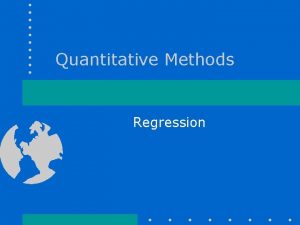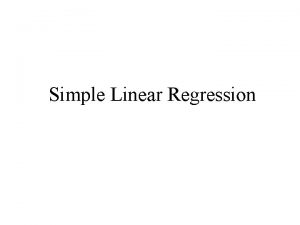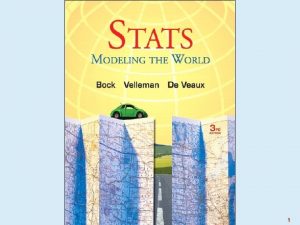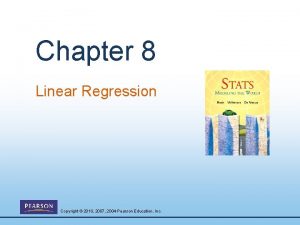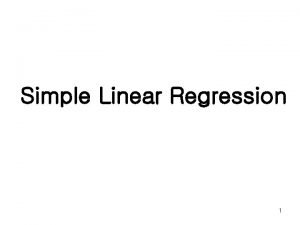Chapter 7 Linear Regression Copyright 2015 2010 2007










































- Slides: 42

Chapter 7 Linear Regression Copyright © 2015, 2010, 2007 Pearson Education, Inc. Chapter 7, Slide 1 -11

Fat Versus Protein: An Example n The following is a scatterplot of total fat versus protein for 30 items on the Burger King menu: Copyright © 2015, 2010, 2007 Pearson Education, Inc. Chapter 7, Slide 1 -22

The Linear Model n n The correlation in this example is 0. 83. Using that value and the graph, last chapter we said “There is a fairly strong, linear, positive association between protein and fat. ” In this chapter we will say more about the linear relationship between two quantitative variables with a linear model. Copyright © 2015, 2010, 2007 Pearson Education, Inc. Chapter 7, Slide 1 -33

The Linear Model (cont. ) n The linear model is just an equation of a straight line through the data. n The points in the scatterplot don’t all line up, but a straight line can summarize the general pattern with only a couple of parameters. n The linear model can help us understand how the values are associated. Copyright © 2015, 2010, 2007 Pearson Education, Inc. Chapter 7, Slide 1 -44

Residuals n n The model won’t be perfect, regardless of the line we draw. As George Box said “All models are wrong, but some models are useful. ” Some points will be above the line and some will be below. The estimate made from a model is the predicted value (denoted as ). Copyright © 2015, 2010, 2007 Pearson Education, Inc. Chapter 7, Slide 1 -55

Residuals (cont. ) n n The difference between the observed value and its associated predicted value is called the residual. To find the residuals, we always subtract the predicted value from the observed one: Copyright © 2015, 2010, 2007 Pearson Education, Inc. Chapter 7, Slide 1 -66

Residuals (cont. ) n n n A negative residual means the predicted value’s too big (an overestimate). A positive residual means the predicted value’s too small (an underestimate). In the figure, the estimated fat of the BK Broiler chicken sandwich is 36 g, while the true value of fat is 25 g, so the residual is – 11 g of fat. Copyright © 2015, 2010, 2007 Pearson Education, Inc. Chapter 7, Slide 1 -77

“Best Fit” Means Least Squares n n n Some residuals are positive, others are negative, and, on average, they cancel each other out. So, we can’t assess how well the line fits by adding up all the residuals. Similar to what we did with deviations, we square the residuals and add the squares. The smaller the sum, the better the fit. The line of best fit is the line for which the sum of the squared residuals is smallest, the least squares line. Copyright © 2015, 2010, 2007 Pearson Education, Inc. Chapter 7, Slide 1 -88

Correlation and the Line n n n The figure shows the scatterplot of z-scores for fat and protein. If a burger has average protein content, it should have about average fat content too. Moving one standard deviation away from the mean in x moves us r standard deviations away from the mean in y. Copyright © 2015, 2010, 2007 Pearson Education, Inc. Chapter 7, Slide 1 -99

Correlation and the Line (cont. ) n Put generally, moving any number of standard deviations away from the mean in x moves us r times that number of standard deviations away from the mean in y. Copyright © 2015, 2010, 2007 Pearson Education, Inc. Chapter 7, Slide 1 -1010

How Big Can Predicted Values Get? n n r cannot be bigger than 1 (in absolute value), so each predicted y tends to be closer to its mean (in standard deviations) than its corresponding x was. This property of the linear model is called regression to the mean; the line is called the regression line. Copyright © 2015, 2010, 2007 Pearson Education, Inc. Chapter 7, Slide 1 -1111

The Regression Line in Real Units n n n Remember from Algebra that a straight line can be written as: In Statistics we use a slightly different notation: We write to emphasize that the points that satisfy this equation are just our predicted values, not the actual data values. This model says that our predictions from our model follow a straight line. If the model is a good one, the data values will scatter closely around it. Copyright © 2015, 2010, 2007 Pearson Education, Inc. Chapter 7, Slide 1 -1212

The Regression Line in Real Units(cont. ) We write b 1 and b 0 for the slope and intercept of the line. n b 1 is the slope, which tells us how rapidly changes with respect to x. n n b 0 is the y-intercept, which tells where the line crosses (intercepts) the y-axis. Copyright © 2015, 2010, 2007 Pearson Education, Inc. Chapter 7, Slide 1 -1313

The Regression Line in Real Units (cont. ) n In our model, we have a slope (b 1): n The slope is built from the correlation and the standard deviations: n Our slope is always in units of y per unit of x. Copyright © 2015, 2010, 2007 Pearson Education, Inc. Chapter 7, Slide 1 -1414

The Regression Line in Real Units (cont. ) n In our model, we also have an intercept (b 0). n The intercept is built from the means and the slope: n Our intercept is always in units of y. Copyright © 2015, 2010, 2007 Pearson Education, Inc. Chapter 7, Slide 1 -1515

Technology n n We almost always use technology to find the equation of the regression line. Your calculator has a Linear Regression tool. Computer software makes a table for regression. This table is what is usually provided on the AP exam. Copyright © 2015, 2010, 2007 Pearson Education, Inc. Chapter 7, Slide 1 -1616

Computer regression Copyright © 2015, 2010, 2007 Pearson Education, Inc. Chapter 7, Slide 1 -1717

Fat Versus Protein: An Example n The regression line for the Burger King data fits the data well: n The equation is The predicted fat content for a BK Broiler chicken sandwich (with 30 g of protein) is 6. 8 + 0. 97(30) = 35. 9 grams of fat. Copyright © 2015, 2010, 2007 Pearson Education, Inc. Chapter 7, Slide 1 -1818

The Regression Line in Real Units (cont. ) n Since regression and correlation are closely related, we need to check the same conditions for regressions as we did for correlations: n Quantitative Variables Condition n Straight Enough Condition n Outlier Condition Copyright © 2015, 2010, 2007 Pearson Education, Inc. Chapter 7, Slide 1 -2020

Residuals Revisited The linear model assumes that the relationship between the two variables is a perfect straight line. The residuals are the part of the data that hasn’t been modeled. Data = Model + Residual or (equivalently) Residual = Data – Model Or, in symbols, n Copyright © 2015, 2010, 2007 Pearson Education, Inc. Chapter 7, Slide 1 -2121

Residuals Revisited (cont. ) n n n Residuals help us to see whether the model makes sense. When a regression model is appropriate, nothing interesting should be left behind. After we fit a regression model, we usually plot the residuals in the hope of finding…nothing. Copyright © 2015, 2010, 2007 Pearson Education, Inc. Chapter 7, Slide 1 -2222

Residuals Revisited (cont. ) n The residuals for the BK menu regression look appropriately boring: Copyright © 2015, 2010, 2007 Pearson Education, Inc. Chapter 7, Slide 1 -2323

The Residual Standard Deviation n The standard deviation of the residuals, se, measures how much the points spread around the regression line. Check to make sure the residual plot has about the same amount of scatter throughout. Check the Equal Variance Assumption with the Does the Plot Thicken? Condition. We can interpret se in the context of a data set. It is the typical error in the predictions made by the regression line. Copyright © 2015, 2010, 2007 Pearson Education, Inc. Chapter 7, Slide 1 -2525

R 2—The Variation Accounted For n n The variation in the residuals is the key to assessing how well the model fits. In the BK menu items example, total fat has a standard deviation of 16. 4 grams. The standard deviation of the residuals is 9. 2 grams. Copyright © 2015, 2010, 2007 Pearson Education, Inc. Chapter 7, Slide 1 -2626

R 2—The Variation Accounted For (cont. ) n n If the correlation were 1. 0 and the model predicted the fat values perfectly, the residuals would all be zero and have no variation. As it is, the correlation is 0. 83—not perfection. However, we did see that the model residuals had less variation than total fat alone. We can determine how much of the variation is accounted for by the model and how much is left in the residuals. Copyright © 2015, 2010, 2007 Pearson Education, Inc. Chapter 7, Slide 1 -2727

R 2—The Variation Accounted For (cont. ) n n n The squared correlation, r 2, gives the fraction of the data’s variance accounted for by the model. Thus, 1 – r 2 is the fraction of the original variance left in the residuals. For the BK model, r 2 = 0. 832 = 0. 69, so 31% of the variability in total fat has been left in the residuals. Copyright © 2015, 2010, 2007 Pearson Education, Inc. Chapter 7, Slide 1 -2828

R 2—The Variation Accounted For (cont. ) n n All regression analyses include this statistic, although by tradition, it is written R 2 (pronounced “R-squared”). An R 2 of 0 means that none of the variance in the data is in the model; all of it is still in the residuals. When interpreting a regression model you need to Tell what R 2 means. n In the BK example, 69% of the variation in total fat is accounted for by variation in the protein content. Copyright © 2015, 2010, 2007 Pearson Education, Inc. Chapter 7, Slide 1 -2929

2 How Big Should R Be? n n R 2 is always between 0% and 100%. What makes a “good” R 2 value depends on the kind of data you are analyzing and on what you want to do with it. The standard deviation of the residuals can give us more information about the usefulness of the regression by telling us how much scatter there is around the line. Copyright © 2015, 2010, 2007 Pearson Education, Inc. Chapter 7, Slide 1 -3030

Reporting R n n 2 Along with the slope and intercept for a regression, you should always report R 2 so that readers can judge for themselves how successful the regression is at fitting the data. Statistics is about variation, and R 2 measures the success of the regression model in terms of the fraction of the variation of y accounted for by the regression. Copyright © 2015, 2010, 2007 Pearson Education, Inc. Chapter 7, Slide 1 -3131

Assumptions and Conditions n n Quantitative Variables Condition: n Regression can only be done on two quantitative variables (and not two categorical variables), so make sure to check this condition. Straight Enough Condition: n The linear model assumes that the relationship between the variables is linear. n A scatterplot will let you check that the assumption is reasonable. Copyright © 2015, 2010, 2007 Pearson Education, Inc. Chapter 7, Slide 1 -3232

Assumptions and Conditions (cont. ) n n If the scatterplot is not straight enough, stop here. n You can’t use a linear model for any two variables, even if they are related. n They must have a linear association or the model won’t mean a thing. Some nonlinear relationships can be saved by reexpressing the data to make the scatterplot more linear. Copyright © 2015, 2010, 2007 Pearson Education, Inc. Chapter 7, Slide 1 -3333

Assumptions and Conditions (cont. ) n n It’s a good idea to check linearity again after computing the regression when we can examine the residuals. Does the Plot Thicken? Condition: n Look at the residual plot -- for the standard deviation of the residuals to summarize the scatter, the residuals should share the same spread. Check for changing spread in the residual scatterplot. Copyright © 2015, 2010, 2007 Pearson Education, Inc. Chapter 7, Slide 1 -3434

Assumptions and Conditions (cont. ) n n Outlier Condition: n Watch out for outliers. n Outlying points can dramatically change a regression model. n Outliers can even change the sign of the slope, misleading us about the underlying relationship between the variables. If the data seem to clump or cluster in the scatterplot, that could be a sign of trouble worth looking into further. Copyright © 2015, 2010, 2007 Pearson Education, Inc. Chapter 7, Slide 1 -3535

Reality Check: Is the Regression Reasonable? n n Statistics don’t come out of nowhere. They are based on data. n The results of a statistical analysis should reinforce your common sense, not fly in its face. n If the results are surprising, then either you’ve learned something new about the world or your analysis is wrong. When you perform a regression, think about the coefficients and ask yourself whether they make sense. Copyright © 2015, 2010, 2007 Pearson Education, Inc. Chapter 7, Slide 1 -3636

What Can Go Wrong? n n n Don’t fit a straight line to a nonlinear relationship. Beware extraordinary points (y-values that stand off from the linear pattern or extreme x-values). Don’t extrapolate beyond the data—the linear model may no longer hold outside of the range of the data. Don’t infer that x causes y just because there is a good linear model for their relationship— association is not causation. Don’t choose a model based on R 2 alone. Copyright © 2015, 2010, 2007 Pearson Education, Inc. Chapter 7, Slide 1 -3737

What have we learned? n When the relationship between two quantitative variables is fairly straight, a linear model can help summarize that relationship. n The regression line doesn’t pass through all the points, but it is the best compromise in the sense that it has the smallest sum of squared residuals. Copyright © 2015, 2010, 2007 Pearson Education, Inc. Chapter 7, Slide 1 -3838

What have we learned? (cont. ) n The correlation tells us several things about the regression: n The slope of the line is based on the correlation, adjusted for the units of x and y. n For each SD in x that we are away from the x mean, we expect to be r SDs in y away from the y mean. n Since r is always between – 1 and +1, each predicted y is fewer SDs away from its mean the corresponding x was (regression to the mean). 2 n R gives us the fraction of the response accounted for by the regression model. Copyright © 2015, 2010, 2007 Pearson Education, Inc. Chapter 7, Slide 1 -3939

What have we learned? n The residuals also reveal how well the model works. n If a plot of the residuals against predicted values shows a pattern, we should re-examine the data to see why. n The standard deviation of the residuals quantifies the amount of scatter around the line. Copyright © 2015, 2010, 2007 Pearson Education, Inc. Chapter 7, Slide 1 -4040

What have we learned? (cont. ) n n n The linear model makes no sense unless the Linear Relationship Assumption is satisfied. Also, we need to check the Straight Enough Condition and Outlier Condition with a scatterplot. For the standard deviation of the residuals, we must make the Equal Variance Assumption. We check it by looking at both the original scatterplot and the residual plot for Does the Plot Thicken? Condition. Copyright © 2015, 2010, 2007 Pearson Education, Inc. Chapter 7, Slide 1 -4141

AP Tips n Make sure you can find the following values from a computer’s regression output. n The explanatory and response variables 2 2 n R (and ignore R (adj. )) n slope and y-intercept n s Copyright © 2015, 2010, 2007 Pearson Education, Inc. Chapter 7, Slide 1 -4242

AP Tips n n Know how to interpret these values in the context of the problem. Make sure to include model words (approximately, about, etc…) when interpreting slope and y-intercept. Without those words, you will not receive full credit. Be able to take the square root of R 2 to find the correlation coefficient and give it the appropriate sign (+ or -). Know that r is generally called “the correlation coefficient” on AP problems Copyright © 2015, 2010, 2007 Pearson Education, Inc. Chapter 7, Slide 1 -4343

AP Tips n n Know how to calculate an individual residual and interpret its value in context. Always write regression equations with the data variables (not x and y) and put a hat over the yvariable name. Copyright © 2015, 2010, 2007 Pearson Education, Inc. Chapter 7, Slide 1 -4444
 Simple multiple linear regression
Simple multiple linear regression Survival analysis vs logistic regression
Survival analysis vs logistic regression Logistic regression vs linear regression
Logistic regression vs linear regression Multiple regression vs linear regression
Multiple regression vs linear regression Copyright 2015 all rights reserved
Copyright 2015 all rights reserved Copyright © 2015 all rights reserved
Copyright © 2015 all rights reserved Excel
Excel Regression in excel 2007
Regression in excel 2007 Copyright 2007
Copyright 2007 Copyright 2007
Copyright 2007 Chapter 7 linear regression
Chapter 7 linear regression Chapter 8 linear regression
Chapter 8 linear regression Chapter 8 linear regression
Chapter 8 linear regression Iso 22301 nhs
Iso 22301 nhs 2010 pearson education inc
2010 pearson education inc C-929-a
C-929-a Variazioni finanziarie attive
Variazioni finanziarie attive Copyright 2010 pearson education inc
Copyright 2010 pearson education inc Copyright 2010 pearson education inc
Copyright 2010 pearson education inc Copyright 2010
Copyright 2010 Copyright 2010
Copyright 2010 Copyright 2010 pearson education inc
Copyright 2010 pearson education inc Copyright 2010 pearson education inc
Copyright 2010 pearson education inc Copyright 2010 pearson education inc
Copyright 2010 pearson education inc Copyright 2010 pearson education inc
Copyright 2010 pearson education inc Copyright 2010 pearson education inc
Copyright 2010 pearson education inc Copyright 2010 pearson education inc
Copyright 2010 pearson education inc Pearson education inc all rights reserved
Pearson education inc all rights reserved Knn linear regression
Knn linear regression Hierarchical multiple regression spss
Hierarchical multiple regression spss Linear regression riddle b
Linear regression riddle b Scala meter
Scala meter Multiple linear regression model
Multiple linear regression model Pengertian regresi linier
Pengertian regresi linier Linear regression spss
Linear regression spss Cost function in machine learning
Cost function in machine learning Gradient descent multiple variables
Gradient descent multiple variables Sum of squares
Sum of squares Ap statistics linear regression
Ap statistics linear regression Example of regression analysis
Example of regression analysis Log linear regression model
Log linear regression model Anova table with formulas
Anova table with formulas Log linear regression model
Log linear regression model






